Bengaluru: The European Union’s space agency, the European Space Agency, has announced its themes around which missions during the years 2035-2050 will focus. The missions that will be selected to launch in these years will focus on the moons of giant planets beyond Mars, including a potential lander or a drone on an icy moon.
There will also be missions that will focus on understanding the Milky Way galaxy and exoplanets within it, and physical probes or instrumentation to better understand the early universe. Long-term investment is expected to occur in areas like cold atom interferometry for atomic clock development, X-ray interferometry for the future study of compact objects, ability to power long-distance missions, and technology to store cryogenic samples of ices for a future sample return mission from beyond the asteroid belt.
The themes include the areas of focus for the next three large-class missions, future medium-class missions, as well as recommendations for long-term technology development. Medium-class missions will focus on all domains of space science such as astronomy, theoretical physics, and astrometry (measuring distances and locations of astronomical objects).
These subjects of investment and research signal key areas of international collaboration, not just with space agencies, but also within the research and scientific community.
The actual missions will be selected after calls are issued for mission proposals for each and are evaluated. The evaluation of these themes is made under the Cosmic Vision science programme which splits space missions into planning cycles. Planning for these missions, called Voyage 2050, will commence shortly.
“The selection of the Voyage 2050 themes is a pivotal moment for ESA’s science programme, and for the future generation of space scientists and engineers,” said Günther Hasinger, ESA Director of Science, in an accompanying statement.
“Now that Cosmic Vision has taken shape with a clear plan for our missions until the mid 2030s, we must start planning the science and the technology we’ll need for the missions we want to launch decades from now, and that is why we are defining the top-level science themes of the Voyage 2050 plan today.”
The themes were decided after evaluating ideas, for which a call was issued in March 2019 and which generated nearly 100 ideas and white papers from the scientific community.
Also read: Moon & Mars done, Jupiter & Uranus next on the list — China’s racing away in space too
The 4 questions
ESA has operated on this Cosmic Vision cycle for a few decades now. The current planning cycle is Cosmic Vision 2015-2025, which was created in 2005. Before that, the Horizon 2000 plan was prepared in 1984, and the Horizon 2000 Plus plan in 1994-95.
The Cosmic Vision programme, through ESA’s deep space exploratory and research activities, aims to answer four questions — What are the conditions for planet formation and the emergence of life? How does the solar system work? What are the fundamental physical laws of the Universe? How did the Universe originate and what is it made of?
As a part of the current cycle, the Jupiter Icy Moons Explorer or JUICE mission is expected to launch next in 2022 to study the moons Europa, Ganymede, and Callisto.
Also read: Why the quest for life on Mars continues despite 35 failed missions since 1960s



